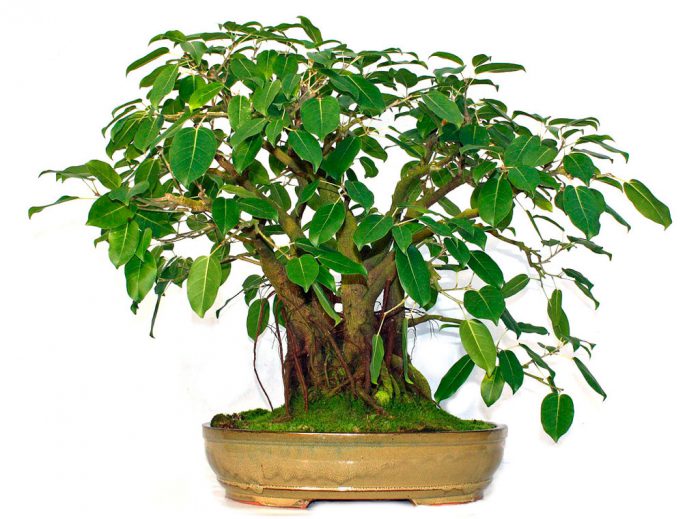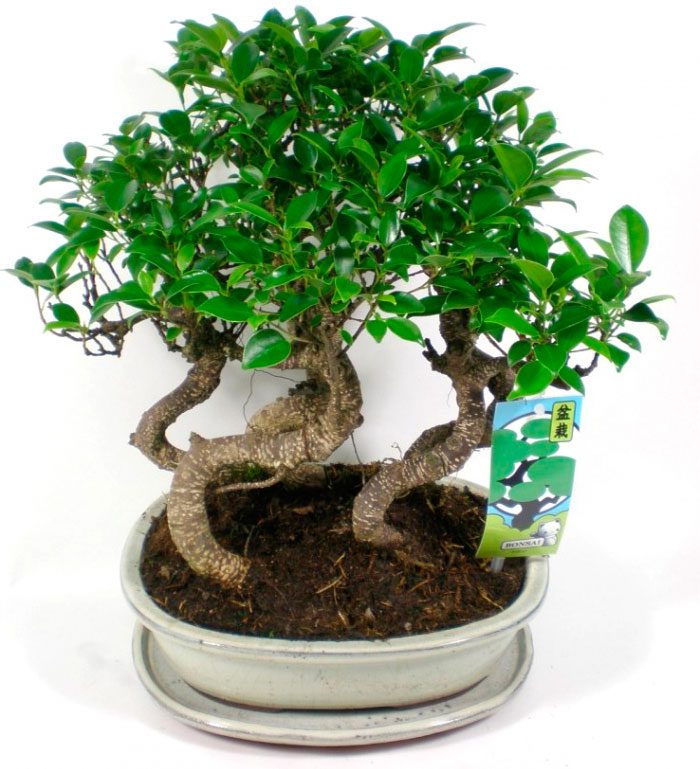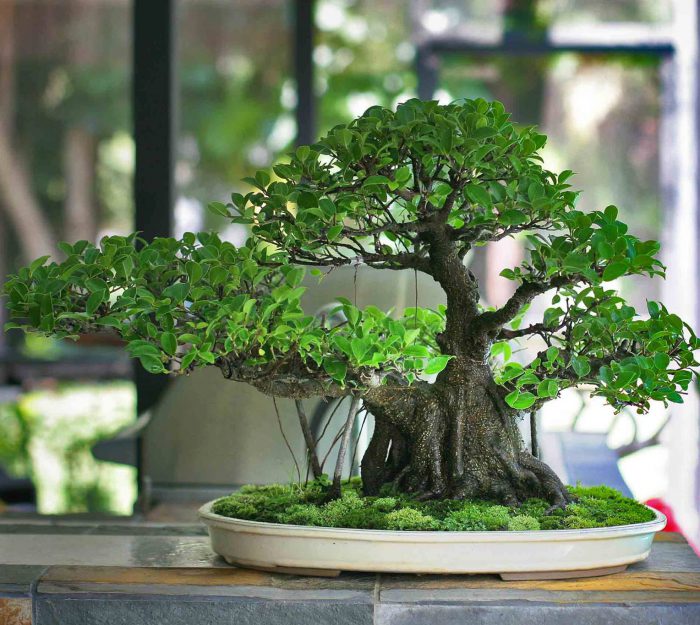Ficus sacred or the religious ficus (Ficus religiosa) is a semi-deciduous or deciduous tree belonging to the genus Ficus and the mulberry family (Moraceae). In nature, it is found in the southwestern part of China, in Sri Lanka, Burma, India, Nepal, as well as in the regions of Indochina.
This tree is quite powerful and in the wild it can reach a height of 30 meters. It has strong branches, a wide crown and impressive leathery leaves of a fairly large size. Simple leaves can be up to 20 centimeters long, their edges are straight and slightly wavy. Their base is wide-heart-shaped, and the apex is very long, elongated into a thin "tail". Green smooth leaves have a bluish tint and pronounced pale veins. The alternate leaves have petioles, the length of which is equal to the length of the leaf plate itself.
The inflorescences are axillary and have the form of small, smooth, spherical syconia, which are also paired. They are colored green, which changes over time to dark purple. You cannot eat them.
Most often, the sacred ficus begins to grow like an epiphyte. He can settle on a crevice in a building or on tree branches. Then it takes out long aerial roots that rush to the surface of the earth. Having reached it, they take root and turn into a rather strong trunk, which becomes a support for the plant. It happens that as it grows, the trunk takes the form of a banyan tree.
Also, this type is distinguished by its interesting feature. If the air humidity is very high, then small droplets of water form at the ends of the leaves. This phenomenon is called guttation. One might get the impression that the ficus is "crying".
This plant received its specific name due to the fact that Buddhists consider it sacred. There is a legend that says that sitting under this plant, Siddhartha Gautama was able to achieve enlightenment and become a Buddha. For many hundreds of years, such a ficus plant has been necessarily planted near Buddhist temples, and pilgrims still tie colorful ribbons to its branches.
Content
Caring for sacred ficus at home
The sacred ficus is quite easy to grow indoors, as it is not very whimsical and not capricious. However, in order for the plant to be strong and healthy, you should know a few simple rules of care.
Illumination
It grows well in bright, but with this diffused lighting, but it feels quite comfortable in a slightly shaded place. A suitable illumination level is 2600-3000 lux. Ficus is recommended to be placed near a window of either western or eastern orientation.
If there is not enough light for the plant, then the leaves may fall off.
Temperature regime
Loves warmth very much. So, in the warm season, it is recommended to grow it at a temperature of 20 to 25 degrees. In winter, make sure that the room is not colder than 15 degrees. A dormant period is not necessary for such a plant; it can grow and develop normally in a warm room in winter. But it should be borne in mind that it must be removed away from heating appliances.
Does not tolerate sudden temperature changes, drafts. With a sharp change in the conditions of detention, foliage can fly around.
How to water
We need a systematic and fairly abundant watering. However, make sure that no water stagnates in the soil. As a rule, the plant is watered only after the top layer of the substrate is slightly dry. Water for irrigation must be kept at room temperature.
Humidity
High humidity is not necessary at all, but in these conditions the plant feels best. For large ficuses, the usual methods of increasing moisture are not suitable. If the air in the room is too dry, then you can use the "artificial fog generator". And even if there is an artificial reservoir, you can place a ficus near it.
If the humidity is too low, then all the leaves of the plant may fall off.
Earth mix
Suitable soil should be loose, nutrient-rich with a pH of 6–6.5. You can buy ready-made soil mixture for ficuses. And if you wish, you can cook it with your own hands. To do this, it is necessary to combine peat, sod and leafy soil, as well as coarse sand, taken in equal shares. Don't forget to have a good drainage layer to avoid soil acidification.
Fertilizer
Top dressing is carried out 2 times a month. For this, mineral and organic fertilizers are used, which should be alternated. Fertilizers should contain a lot of potassium and nitrogen.
Transplant features
It is a fast growing plant. So, as a rule, in 12 months a small seedling can become a two-meter tree. In this regard, young specimens need frequent replanting (1 or 2 times a year). In this case, the transplant, as a rule, is carried out after the root system ceases to fit into the pot. Too large ficuses are not transplanted, but only replace the upper layer of the substrate with them.
Pruning
You need to regularly cut off young stems in order to restrain plant growth and form a neat crown. Pruning is carried out before the start of the period of intensive growth, and later it will be possible to pinch the tips of young branches.
Formation features
In addition to pruning branches, there is another equally effective way to form a spectacular crown. The shoots of the sacred ficus are highly elastic. With the help of a special wire frame, you can set any direction for young stems.
A very popular way to form young plants is to braid their trunks into a pigtail. But for this, 3-4 ficus should be planted in one container at once.
Reproduction methods
You can propagate sacred ficus quite quickly and simply with the help of seeds. This method is most popular with flower growers. Sowing seeds must be done exactly according to the instructions on the package. As a rule, the appearance of seedlings occurs after a week.
This plant can also be propagated by cuttings, but very often the cuttings do not take root.
Pests and diseases
Can settle on a tree aphid, mealybug, shield or thrips... If you notice pests, then the ficus will need to be treated with special chemicals as soon as possible. Processing must be done very carefully so as not to poison yourself.
Most often, the plant is sick due to the fact that it is not properly looked after. So, due to any change in care, all the foliage may fall off.
However, it must be remembered that the leaves of the ficus fall off themselves, reaching two or three years of age. In this regard, the fall of foliage can be a completely natural process.














